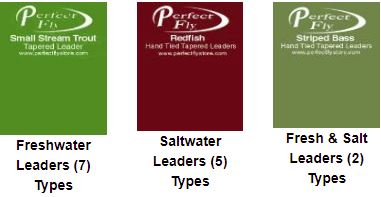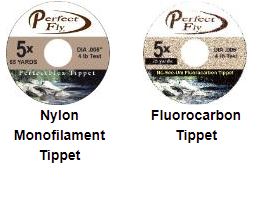Leaders
A fly fishing leader serves two very important purposes. It conceals the fly line and it serves in the delicacy of the presentation. Like your rod and fly line, the leader should be tapered. Factory made knotless tapered leaders are the most popular types for trout. They are gradually and uniformly tapered throughout their length. We have our own Perfect Fly line of tapered leaders.
Knotted, leaders are made by people. They have a large diameter butt section that quickly tapers down to a level tippet to best suit specific fishing applications. Knotless and knotted leaders each have their advantages and disadvantages.Many of our specialty leaders are hand made by us. Knotted leaders tend to cast better and present the fly in a more delicate manner that the factory made knotless leaders because they are not uniformly tapered from the butt section to the tippet.
Made properly, the longer, larger butt section of a knotted leader and quicker taper are easier to cast in such a manner as to completely straighten the leader. This is especially true if there is much wind. Longer, lighter knotless lines are more difficult to cast in such a manner as to completely straighten the entire length of the leader. The down side of a knotted leader is the fact that the knots tend to catch debris and vegetation in the water more so than the knotless leaders.
Certainly you can get by in almost any fly fishing situation using factory made knotless leaders; however, the more the leader size, length and taper is refined for certain types of water, current and wind conditions, as well as the type of fly presentation needed for certain species of fish, the more you increase your odds of success, so our hand made leaders have their place and purpose as well.
Tippet
The tippet is the final deceptive component in the overall fly-fishing system and of course, is what the fly is tied to.You probably can’t even see it in this shot. It is also the weakest link in the overall system. We have two basic types – monofilament nylon tippet and fluorocarbon tippet.
The larger the tippet, the more difficult it is to make the fly look and act natural. So, from the standpoint of the presentation the tippet should be as small in diameter as possible. However, since the tippet is also the weakest link between the angler and the fish, a balance of choices must be made between the quality of presentation of the fly and the risk of a fish breaking the tippet.
Tippet Size and Designations:
Smaller size leaders are designated by their length and the tippet size number, which is designated by a “X†that identify the size and breaking strength of the tippet. The larger the number immediately preceded by “X†the smaller the diameter and lower the breaking strength of the tippet. Larger size leaders do not use the “X†system to designate size. They are identified as being extra light, light, medium, heavy or extra heavy and may also be designated by the diameter of the tippet. If the tippet size is larger than the zero â€X†size designation, they are referred to by length and tippet size designated as the tested breaking strength. For instance, a designation of a tippet may be, a nine, foot leader with a .015-inch diameter tippet, or nine-foot leader with a breaking strength of ten pounds.
The larger the fly, the larger the size tippet you can use without it adversely affecting the presentation of the fly. For example, this larger size streamer fly can be effectively presented on a much larger size tippet than this very small dry fly. Ideally, you would use a very small, light tippet for the dry fly – as small as possible without it compromising your ability to successfully fight and land the fish. Most anglers would much rather take their chances fighting a fish on light tackle than to fish heavier tackle knowing that their chances of getting a strike are little or none.
The length of the tippet is, of course, reduced each time you tie on a fly. At some point, the reduction in tippet length will began to adversely affect the presentation of your fly. For this reason, it is smart to tie on a new tippet of the proper length or change to a new leader altogether any time the tippet becomes too short.
Long tippets are more so affected by wind than shorter ones. In fact, wind can easily form an overhand knot in the tippet during a cast. This effectively reduces the breaking strength of the tippet as well as the presentation of the fly. As a rule of thumb, you should always use the smallest size leader and tippet that you can get away with.

